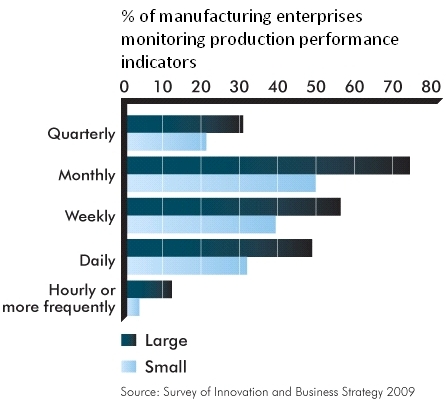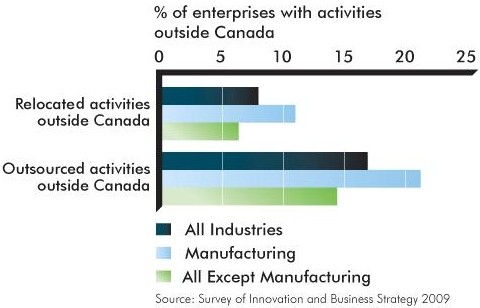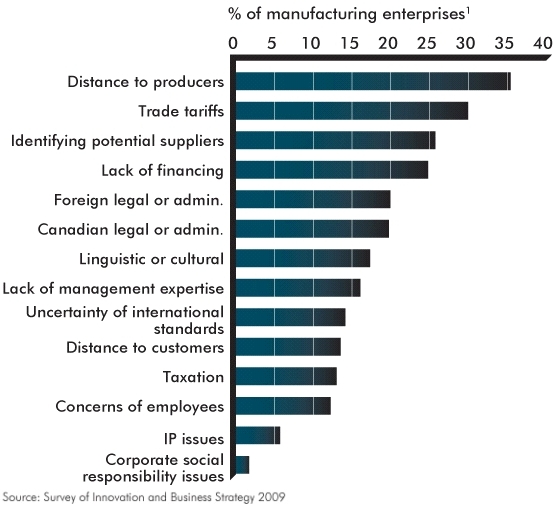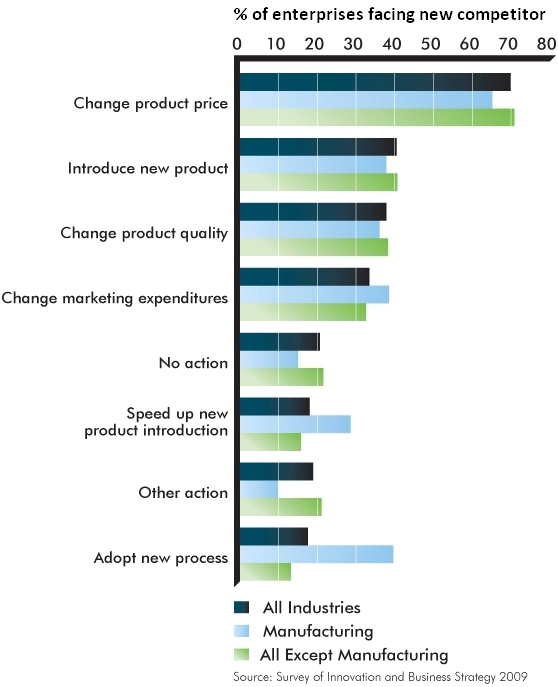PDF version
Archived
Highlights of the Survey
Business strategies
The main strategic focus of enterprises in Canada is oriented toward exploiting existing products or current activities rather than developing new ones.
Figure 1 shows that more than 3 out of 4 (77.1%) enterprises in Canada focus on maintaining or expanding the sales of existing goods or services. Nearly 1 out of 5 (18.8%) enterprises reported that they focus on introducing new or significantly improved goods or services.
Figure 1: Percentage of Enterprises with a Strategic Focus on Existing Products or Activities – All Enterprises, Canada, 2009

Overall, 78.6% of all enterprises reported that product positioning is more important than low-price or cost leadership (21.4%). The majority of enterprises seek to maintain, intensify or optimize their current business activities, whether it be in relation to marketing, operational or other organizational activities. The survey also reveals that enterprises in the manufacturing sector are slightly more focussed on introducing new products, practices or activities compared to businesses in other sectors of the Canadian economy.
Innovation
Enterprises in Canada reported strong complementarities between innovation and other activities.
Over the 2007–2009 period, 2 out of 3 (66.8%) enterprises in Canada reported having introduced some kind of innovation. Specifically,
- 18.1% of all enterprises introduced new or significantly improved good and 24.5% a new or significantly improved service (product innovation);
- 12.0% introduced a new or significantly improved logistics, delivery or distribution method for their inputs, goods or services (process innovation);
- 23.5% introduced a new business practice for organizing procedures (organizational innovation);
- 23.9% introduced a new medium or technique for goods or services promotion (marketing innovation).
Figure 2 shows that a significant percentage of enterprises that undertook process or product innovations implemented changes to a range of business activities. In particular, 59.5% of all product innovators reported implementing changes to their marketing activities, 67.7% to their operational activities and 50.3% to their organizational activities.
Figure 2: Percentage of Enterprises for which Process and Product Innovations Require Changes to Business Activities – All Process or Product Innovative Enterprises, Canada, 2007–2009

Obstacles to Innovation
Uncertainty and risk is the most important obstacle to innovation for enterprises in Canada.
Findings also suggest that the relative importance of some longstanding obstacles to innovation might have been overstated. In 2009, the three most important obstacles reported were uncertainty and risk, lack of skills and internal financing (Figure 3). More than one third (36.6%) of all enterprises in Canada reported that uncertainty and risk is an obstacle to innovation, while only 4.5% reported that intellectual property protection was an impediment.
Figure 3: Percentage of Enterprises Reporting Obstacles to Innovation – All Enterprises, Canada, 2009

External financing (16.2%) and regulatory issues (15.9%) are obstacles to innovation for less than 1 in 5 businesses in Canada. Except for the issue of finding external collaborators, a greater proportion of enterprises in the manufacturing sector reported facing obstacles to innovation relative to other sectors of the Canadian economy.
Performance Management Practices
Large manufacturing enterprises in Canada monitor an extensive array of performance metrics more frequently than their smaller counterparts. They are also more likely to have systematic processes and procedures in place to resolve problems associated with the production of goods or the delivery of services.
Large manufacturing enterprises with 250 employees or more monitored, on average, 18.5 production performance indicators. Figure 4 shows that this extensive array of performance indicators are shown to the managers of operations in large manufacturing enterprises more often than in small ones for all frequencies considered.
Figure 4: Percentage of Enterprises Reporting the Frequency at which Production Performance Indicators are Shown to Managers of Operations – Manufacturing Enterprises Monitoring Production Performance Indicators, Canada, 2009

In addition, more than 4 out of 5 large (86.2%) enterprises in the Canadian manufacturing sector reported having a systematic process or procedure to resolve problems associated with the production of goods or delivery of services. By contrast, 64.7% of small enterprises reported having implemented such a process.
Advanced Technology
Most enterprises in Canada that use advanced technologies are off-the-shelf adopters.
In 2009, 83.4% of all enterprises that used advanced technologies reported having acquired an advanced technology by purchasing it off-the-shelf. In comparison, about 1 out of 4 of these enterprises reported to have customized an advanced technology (23%) or to have developed it (16.3%).
Figure 5 shows that enterprises in the manufacturing sector were more likely to use various advanced information and communication technologies, such as advanced computerized technologies, advanced automated technologies and advanced information integration and control technologies. The only notable exception is advanced communication technologies, which are used by a higher percentage of enterprises outside the manufacturing sector (29% vs 23.7%).
Figure 5: Percentage of Enterprises Using Advanced Information and Communications Technologies – All Enterprises, Canada, 2009

Global Value Chain Management
International markets are important for enterprises in Canada with nearly 1 in 4 enterprises, and 1 out of 2 in the manufacturing sector, having some business activities outside of Canada.
Between 2007 and 2009, 24.7% of all enterprises reported having business activities outside of Canada. The share was higher for manufacturers, with 47.5% having business activities outside of Canada.
However, of those enterprises with activities abroad, only 7.8% relocated business activities from Canada to another country in the past three years, and only 16.8% outsourced business activities from Canada to another country between 2007 and 2009.
Figure 6: Percentage of Enterprises with Activities Outside Canada, having Relocated or Outsourced Activities Outside Canada — All Enterprises with Activities Outside Canada, 2007–2009

Barriers to Entering Global Value Chains
For manufacturers in Canada, distance to producers and trade tariffs are the largest obstacles to sourcing business activities abroad.
Of those manufacturing enterprises that moved business activities abroad between 2007 and 2009, 35.5% reported distance to producers as an obstacle of high importance to relocating or outsourcing their business activities abroad (Figure 7). Trade tariffs was reported as the second highest obstacle with 30.2% of enterprises reporting it as being of high importance.
Other obstacles were found to be relatively less important. Only 1.7% of manufacturing enterprises that had relocated or outsourced abroad reported corporate social responsibility issues as a highly important obstacle and only 5.8% listed violation of patents or intellectual property rights as an obstacle of high importance.
Figure 7: Percentage of Manufacturing Enterprises Indicating that the Degree of Importance of the Obstacles to Relocation or Outsourcing they Faced was High — Manufacturing EnterprisesFootnote 1, Canada. 2007–2009

Competition and the Marketplace
Enterprises in Canada reported strong competition in their main market, but when faced with entry by a new competitor less than half introduce either a new product or speed up the introduction of one.
The findings show that the main market for most enterprises in Canada is mostly domestic, not global. In 2009, 90.8% of the sales of all enterprises' main products occurred in Canada, while 6.6% came from the U.S. market and 2.6% from the rest of the world. For manufacturing enterprises the international market is more important with more than one quarter of sales occurring abroad.
Despite, this focus on Canadian markets, competition intensity appears relatively strong. For example, 78.2% of enterprises in Canada reported facing at least four competitors in their main market in 2009, while 65.7% reported more than five. Furthermore, almost one third (32.4%) of all enterprises in Canada reported that at least one competitor entered their main market in 2009.
Figure 8 shows that the vast majority of businesses in Canada react to competitive entry by changing the price of their main product (69.5%), while 40.1% reported introducing a new product, and 18.1% reported speeding up the introduction of a new product.
Figure 8: Percentage of Enterprises Indicating their Reaction to the Entry of New Competitors in their Main Market — All Enterprises Facing New Competitors, Canada, 2009

